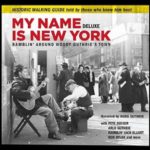
Woody Guthrie hardly invented the Americana movement in American music, which is as popular as ever today thanks to artists like Jack White and the Avett Brothers. But he did play a leading role in popularizing Americana with a national audience in the 1940s, helping pave the way for the folk, bluegrass, blues and country scenes that unfurled un later years.
Although Guthrie was a native Oklahoman who often sang of wide open spaces and a simpler life, he made his mark in New York City, where he moved in 1940 and spent most of the rest of his life. My Name is New York – Ramblin’ Around Woody Guthrie’s Town, is technically a 3-CD audiobook but features numerous vintage Guthrie musical performances, along with recollections from friends and relatives and commentary from historians that give some context to what makes his music so compelling all these years later.
A number of the featured songs directly relate to how tough life in New York could be for a small-town newcomers. “New York Town,” featuring vocals and guitar from blues legend and close Guthrie friend Lead Belly, as well as harmonica from “Blind” Sonny Terry, tells the all-too-familiar story of being borkke and down on your luck in the heartless big city.
Meanwhile, “New York Transit” tells a more humorous tale of a Texan who comes to the big city with his wife and kids, and finds they can’t get off the subway because of all the people shoving and blocking their way every time the train comes to a stop.
Of course, Guthrie’s songs focused on wider topics than the difficulties of adjusting to life in New York. Spoken commentary informs the listener he wrote “The Ballad of Tom Joad” as the result of direct inspiration from the classic Steinbeck novel “The Grapes of Wrath,” using Pete Seeger’s typewriter in one night while consuming a half-gallon of jug wine. He woke up the next morning to find the finished product in front of him.
Other colorful tales involve Guthrie’s life among the lofts, apartments and communal living arrangements favored by New York’s leftist artists, writers and musicians during the time period. It was also during this time that Guthrie started gaining acclaim and monetary reward performing on New York radio. He also cut “Dust Bowl Ballads,” his first and most successful commercial recording, in 1940 at Victor Record Studios in Camden, N.J., ensuring his place in the national consciousness.
“My Name is New York” does a great job conjuring up a time that was much tougher, but also much more colorful and in some ways carefree, than today. It also illustrates how the man who brought the political singer/songwriter archetype later used by Bob Dylan to revolutionize rock n roll came to be who he was. Guthrie may have been an Okie in his heart, but he was a New Yorker in his head, and the broad worldview the melding of these two different cultures produced changed music and popular culture forever.



No Comments comments associated with this post